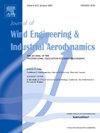Eulerian RANS simulation of pollutant dispersion in atmospheric boundary layer considering anisotropic and near-source diffusivity behavior
IF 4.2
2区 工程技术
Q1 ENGINEERING, CIVIL
Journal of Wind Engineering and Industrial Aerodynamics
Pub Date : 2025-02-05
DOI:10.1016/j.jweia.2025.106036
引用次数: 0
Abstract
This study proposes an anisotropic concentration diffusivity model in the Reynolds-averaged Navier-Stokes equations (RANS) and the Eulerian dispersion model. The proposed model combines models to consider the turbulent anisotropic and near-source limited diffusivity based on the generalized gradient-diffusion hypothesis and travel time. The proposed model and conventional isotropic models were applied to predict the pollutant dispersion in an atmospheric boundary layer from elevated and ground-level sources. The predicted concentration profile and plume half-width were validated with a previous wind tunnel experiment in the literature. Both the proposed and isotropic models using the diffusivity limiter accurately predicted the mean concentration profiles at the central vertical plane. The isotropic models did not accurately predict the horizontal and vertical plume widths of the ground-level source while the proposed model successfully predicted those. The equivalent turbulent Schmidt numbers in the proposed model differed in each direction. The proposed model predicted counter-gradient turbulent diffusion in the streamwise direction. In addition, accurate Reynolds stress was found to be crucial for reproducing the anisotropic concentration diffusivity in the proposed model.
考虑各向异性和近源扩散特性的大气边界层污染物扩散的欧拉RANS模拟
本文在reynolds -average Navier-Stokes方程(RANS)和Eulerian色散模型中提出了各向异性浓度扩散系数模型。该模型结合了基于广义梯度扩散假设和行程时间的湍流各向异性和近源有限扩散率模型。应用该模型和传统的各向同性模型对大气边界层中来自高空源和地面源的污染物扩散进行了预测。预测的浓度分布和羽流半宽度已通过文献中先前的风洞实验得到验证。采用扩散限制器的各向同性模型和采用扩散限制器的各向同性模型都能准确地预测中心垂直面上的平均浓度分布。各向同性模型不能准确地预测地面源的水平和垂直羽流宽度,而所提出的模型成功地预测了水平和垂直羽流宽度。所提模型的等效湍流施密特数在每个方向上都不同。该模型预测了顺流方向的反梯度湍流扩散。此外,精确的雷诺应力对于再现模型中各向异性浓度扩散系数至关重要。
本文章由计算机程序翻译,如有差异,请以英文原文为准。
求助全文
约1分钟内获得全文
求助全文
来源期刊
CiteScore
8.90
自引率
22.90%
发文量
306
审稿时长
4.4 months
期刊介绍:
The objective of the journal is to provide a means for the publication and interchange of information, on an international basis, on all those aspects of wind engineering that are included in the activities of the International Association for Wind Engineering http://www.iawe.org/. These are: social and economic impact of wind effects; wind characteristics and structure, local wind environments, wind loads and structural response, diffusion, pollutant dispersion and matter transport, wind effects on building heat loss and ventilation, wind effects on transport systems, aerodynamic aspects of wind energy generation, and codification of wind effects.
Papers on these subjects describing full-scale measurements, wind-tunnel simulation studies, computational or theoretical methods are published, as well as papers dealing with the development of techniques and apparatus for wind engineering experiments.

 求助内容:
求助内容: 应助结果提醒方式:
应助结果提醒方式:


